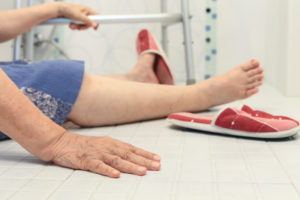‘Manhattan Project in fall injury prevention’ gets under way
Ten healthcare systems from across the country are joining forces in a five-year, $30 million research project that one principal investigator is calling “the Manhattan Project in fall injury prevention.” Plans for the initiative were revealed in a public briefing this afternoon.
The effort, funded by the independent, nonprofit Patient-Centered Outcomes Research Institute (PCORI) and facilitated through the National Institute on Aging (NIA) of the National Institutes of Health, will test a person-centered prevention strategy and use of a “falls care manager” with the goal of educating older adults, care providers and others so that serious injuries from falls—such as hip and other nonspinal fractures, head trauma, joint dislocation, internal injuries, hypothermia and lacerations—can be reduced. Results may provide insights into a new model of care and tips of use to senior living providers and the residents they serve.
Major players
The effort has three principal investigators:
- Shalender Bhasin, MD, of Brigham and Women’s Hospital and Harvard Medical School, Boston;
- Thomas Gill, MD, of Yale School of Medicine, New Haven, Conn.; and
- David Reuben, MD, of the David Geffen School of Medicine at the University of California, Los Angeles.
“We are delighted and honored to be entrusted with the responsibility of leading one of this nation’s most ambitious clinical trials in fall injury prevention,” Bhasin said at the public briefing. “In a manner of speaking, this is the Manhattan Project in fall injury prevention,” he added, referring to the scale of a well-known research and development project during World War II.
Over the course of the project, researchers hope to study 6,000 patients aged 75 or more years who are living in the community and have at least one modifiable risk factor for falls. More than 100 investigators, patients, caregivers and other stakeholders will participate through the 10 health systems involved in the study and entities in the communities in which the systems are located. The systems:
- Essentia Health, Duluth, Minn.
- HealthCare Partners, Torrance, Calif.
- Johns Hopkins Medicine, Baltimore
- Mount Sinai Health System, New York City
- Partners HealthCare, Waltham, Mass.
- Reliant Medical Group, Worcester, Mass.
- University of Iowa Health Alliance, Iowa City
- University of Pittsburgh Medical Center
- University of Texas Medical Branch, Galveston
- University of Michigan, Ann Arbor
Practical application of previous research
“Over the past 20 years and more, there’s been recognition of the importance of falls in the elderly and the great priority of finding a way to intervene to prevent those falls,” said NIA Director Richard J. Hodes. “Prior research has been highly successful in identifying risk factors, to note those people who are at risk and furthermore to show that intervening in an experimental setting to address those risk factors could be highly successful in preventing serious falls.
“What remains at this time,” he added, “is research that will inform into how to best design a study that can take advantage of this prior knowledge and deliver it in practical settings so that it can have the impact that it should on the population who are at highest risk. We think that this study will be unique and play a very critical role, therefore, in understanding the research that exists to date and translating it into real advantage to the public.”
How study will work
Under the model being tested, primary care practices associated with the 10 participating health systems will identify older adults at high risk for falls. Those older adults who choose to participate in the study will be randomly assigned to either receive the current standard of care—they will be given information about how to avoid falling—or to work with a falls care manager—a registered nurse—who will develop a physician-approved falls care plan for each patient, working with a team of physical therapists, occupational therapists, community-based organizations and others to address issues specific to each patient.
As for the falls prevention strategies that will be used as part of the study, Reuben said: “This is an evidence-based study, so anything that is published out there or has been shown to be effective is going to be part of the armamentarium.” He mentioned medication management and changes to footwear as two examples of strategies, noting that physicians may need to alter their prescribing behavior to affect change.
During the first year of the study, which began June 1 and is funded at $7.6 million, researchers will test aspects of intervention with several patients. Enrollment in the full trial, if it proceeds, would start in the second year of the study and last 18 months. Study participants would be followed for up to three years.
Hodes said he hopes this project is one of many collaborations that the NIA will undertake with PCORI.
Related Articles
Topics: Articles , Rehabilitation











